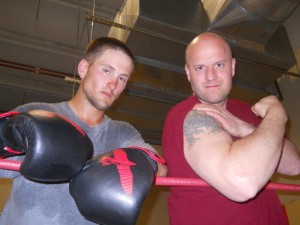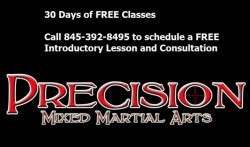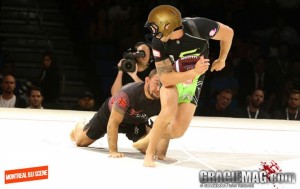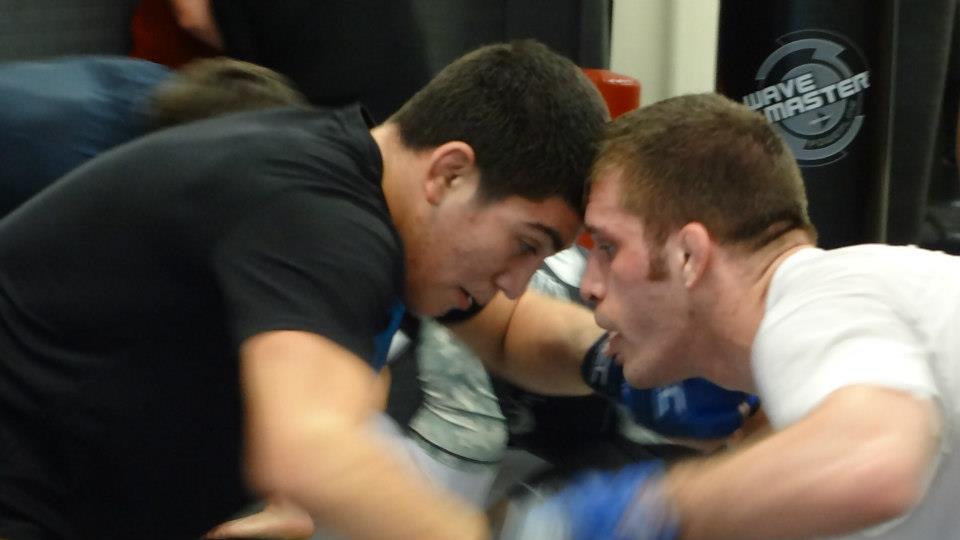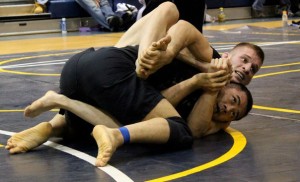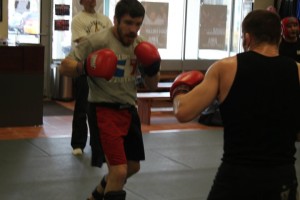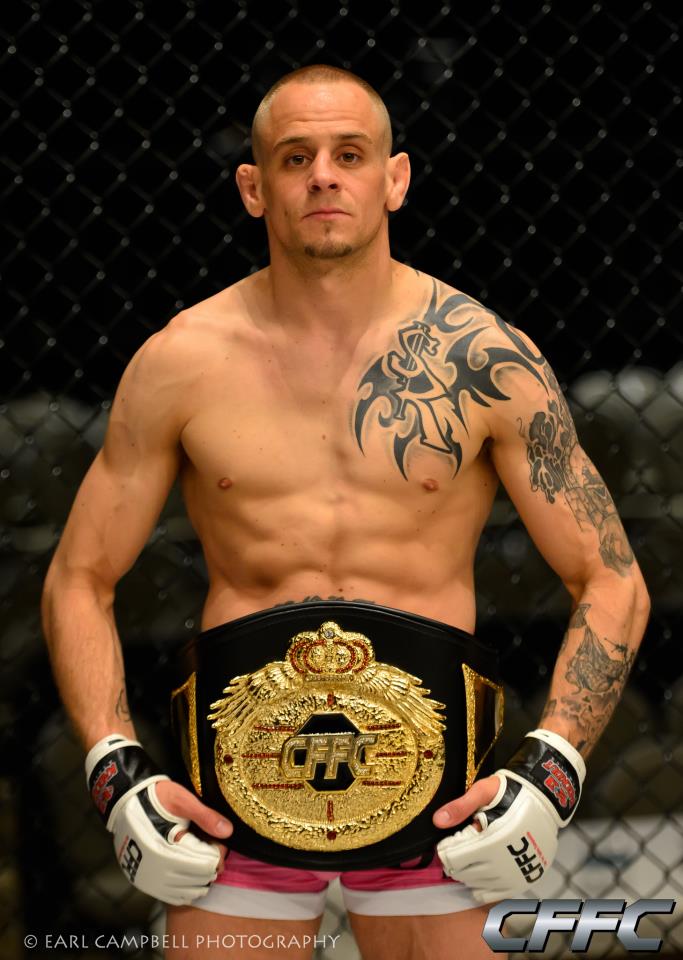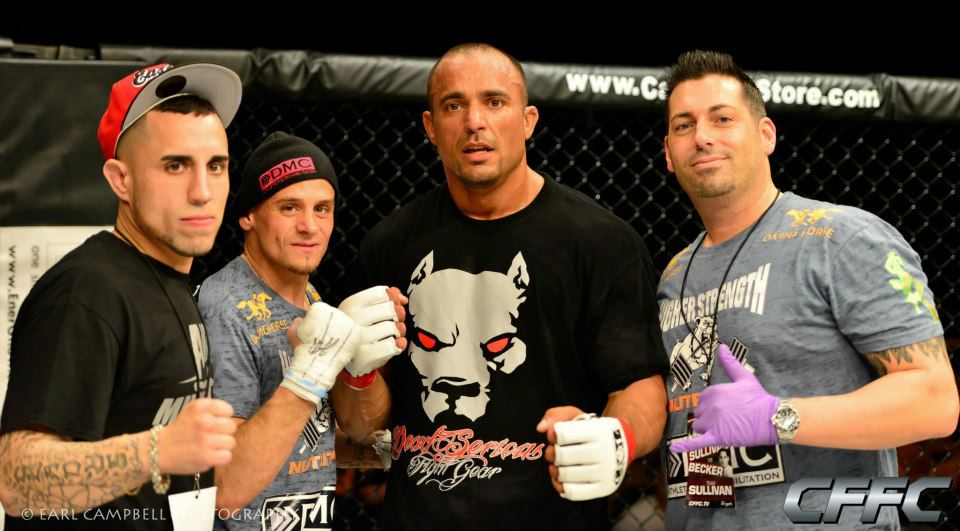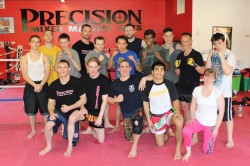Glad Ralek isn’t hiding his head in the sand and pretending things went perfectly. I’m glad to hear a few of the suggestions I mentioned in my prior blog post will be taken to heart – financial incentives for submissions and no more judges!
USA Boxing for Precision MMA Fighters
Dan has the “power” to beat anyone put in front of him (see what I did there…well I think I’m funny). He has a relentless straight ahead style that makes for a great fight every time.
Here’s an old bout of Mr. Power. He’s gotten much better since this bout, but it shows his gutty style of fighting
Paul made a big impression in the finals of the golden gloves recently, giving the champion all he could handle. Paul is a crafty boxer that is looking to put his skills on display. As always Coach Derrick Ohlhoff will be in the corner.
Saturday, June 22, 2013
Match Bouts
Mohawk Baseball at Shuttleworth Park
65 Crescent Ave.
Amsterdam, NY 12010
Weigh-in: 1:00 pm
Bout Time: 3:00 pm
Train Hudson Valley Boxing at Precision MMA for 30 Days FREE call 845-392-8495 or check out http://www.poughkeepsieboxing.com
Precision MMA – Hudson Valley Martial Arts
Here’s a cool article one of my brown belts Jamey Bazes wrote about my Hudson Valley Martial Arts school Precision MMA.
Flower Sweep – Hudson Valley Martial Arts
My favorite sweep of all time is the flower sweep. Regardless of what genre you are dealing with – gi, no-gi or MMA, the flower sweep is a must know
Side Control Madness
No one in BJJ has a better bottom side mount than Javier Vazquez
Metamoris II – Better Luck Next Time
Metamoris 1 was the arguably the most exciting professional jiu-jitsu event ever created. An eclectic assortment of different jiu-jitsu approaches – fast and furious, or slow and methodical, intense or playful all pursuing the ultimate goal of submission. Even when no submission occurred there was a sense that each competitor truly left their heart and soul out on the mat. Metamoris 1 was a landmark, torches were passed, rivalries intensified, questions were answered and even more were asked. Every fan of jiu-jitsu awaited the next event with baited breath.
Metamoris 2 was the worst sequel since The Godfather 3, a failure of colossal proportions unimaginable by even the most pessimistic of individuals. After any horrific tragedy the survivors are left with 1 question…why? Some actions are so deranged that no sense can be made of them; such is the case with Brendan Schaub. The only winner in that situation was Matt Mitrione, who gained a huge army of supporters for his UFC on Fox 8 bout vs Schaub. The question was asked by Rener Gracie, if you had to face Cyborg what would you have done differently? The answer is simple, I would have grappled him. If I boxed Flloyd Mayweather and simply fled the ring every time he came close enough to throw a punch I would not be proud of my performance or kid myself into thinking I somehow benefited the sport of boxing. The match was reminiscent of Nate Quarry’s battle against Kalib Starnes.
http://mma-gifs.tumblr.com/post/25934430624/ufc-83-nate-quarry-vs-kalib-starnes
The Schaub abomination aside, the evening was full of people fighting tooth and nail for bottom position, tug of war lapel battles and monotonous half-hearted foot lock attempts. If not for Kron Gracie and Shinya Aoki there would have been no hope whatsoever.
The purpose of this diatribe is not solely to vent frustration (however cathartic that may be), but to hopefully offer some suggestions in the hopes that the greatness of Metamoris 1 may one day be repeated.
#1 – Create a closed perimeter
Rorian Gracie wanted to avoid having contestants flee the ring when he thought up the UFC. The use of a cage wall accomplished this end. While it is understandable that Metamoris wants to differentiate itself from MMA, some sort of physical barrier is necessary. A padded wall of plexi glass hockey rink esque barrier is necessary. Even in the name of safety the change should be made since multiple times fighters were nearly thrown from the mat.
#2 – No judges
Truthfully Metamoris is in many ways a repackaging of Rose Gracie’s “Gracie Nationals” tournaments. Rose got it right, you can’t get your hand raised unless you go for it. You must pursue the submission, period. The most exciting matches of Metamoris 1 were Xande vs Lister and Roger vs Buchecha. However, those matches were made amazing by the fact that the fighters wanted to win so badly that they constantly attacked. Beautiful submissions coupled with amazing escapes occurred as a result of submission being the only path to victory. The finality of a winner is not terribly important in this event since it is not a tournament and not about promoting the fighters as much as promoting the art. Also, in both cases the court of public opinion picked a clear winner anyway. The ironic part of Metamoris 2 was judges were brought in to prevent a draw and the first two matches were judged as a draw. Finally, it may be a moot point since Kron submitted Aoki, but I couldn’t help but feel like the game was rigged against Shinya since two of the judges could not easily remain impartial – JJ Machado is part of Kron’s extended family and Pedro Sauer is his father’s top black belt, it just seemed unfair if you ask me.
#3 – Disqualifications for stalling, timidity or flat out running away
If a competitor turns his back and runs away then they aren’t there to compete. 5 Minutes into the Brendan Schaub / Cyborg match it became apparent that Schaub wasn’t going to engage anywhere, on the feet or the ground. Simply end the contest and move on. I am a fan of a zero tolerance no warning system, just automatic DQ for obvious offensive. This would be the stalling equivalent to the IBJJF’s knee reaping rule. After the first couple of DQ’s the message would be crystal clear, grapple or lose.
#4 – Metamoris Tryouts
The problem is that grapplers are being brought in and the promoters simply cross their fingers and hope that they will be exciting. I believe that elite grapplers should apply be brought in and made to roll for 20 minutes. The ones who get to compete are those who attempt submissions and are exciting to watch. I don’t care if they aren’t the best or if they get tapped out, if they put on a show they get a chance to compete. Also let it be known that those who do not perform will not be invited back.
#5 – Cash Incentives
I don’t know how athletes are compensated at Metamoris, but putting a carrot on a stick would help encourage action. If a competitor knew they would make 50% more if they hit a submission then you can bet they would be hunting for them. The UFC has done this with performance based pay, the problem is MMA is very dangerous so going for a submission and failing can cost you quite a few brain cells. Jiu-Jitsu does not carry the same risks so hopefully competitors will be compelled to pursue a finish in order to fatten their wallets.
Brian McLaughlin is a Brazilian Jiu-Jitsu black belt and head instructor at Precision Mixed Martial Arts in LaGrange, NY a Hudson Valley Martial Arts School
Dutchess County MMA – Triangle Choke for MMA
A blast from the past, here is one of my favorite triangle chokes for MMA competition. This setup works by tightly controlling the distance, allowing you to work into the submission without giving your opponent an opportunity to land a strike. I’m demonstrating this move on none other than UFC veteran Charlie “The Spaniard” Brenneman at the AMA Fight Club. AMA is where I test the MMA techniques I teach in Dutchess County.
This is a move my students use at my Dutchess County MMA gym Precision MMA in LaGrange, NY – for a 30 Day Free Trial call 845-392-8495 or visit http://www.bjjfighter.com
Hudson Valley MMA – The 33% Rule
The 33% Rule
Hudson Valley Training tactics from Brian McLaughlin head Hudson Valley MMA coach at Precision Mixed Martial Arts in LaGrange, NY
Over the last decade I’ve trained at just about every major MMA gym on the east coast from the Hudson Valley to South Florida. I’ve been an instructor, sparring partner or student of fighters ranging from UFC world champions to first time amateurs – I’ve even seen guys go from their first fight in empty middle school gymnasiums to fighting for 6 figures in front of sold out Las Vegas crowds. In this time I’ve seen a myriad of different training approaches and practice routines all with varying levels of effectiveness. Some gyms focused mainly on striking, others were wrestling based and many had a jiu-jitsu approach – but what I’m going to talk about here transcends styles and techniques. This is the training approach that I believe allows an athlete to put themselves in the best position to be successful – the 33% rule.
The old mantra repeated by just about every guru in the business is “train smarter not harder” but what does that really mean? In my estimation this statement highlights the fact that hard work and effort, at a certain point, yield diminishing returns. Biting down on your mouthpiece and pushing yourself 100% certainly has its place in combat sports, but in order to reach the upper echelons of the sport most agree that a higher level of sophistication is warranted. Therefore, training smarter would be defined as the approach which most efficiently leads an athlete towards improvement without injury or burnout.
The specific area of training I am looking to examine deals with sparring (or rolling for you BJJers) partners. The prevailing wisdom is that you’re only as good as your training partners. Therefore, in order to progress a student should work with the highest caliber partners available. The more skilled the sparring partner the better. Admittedly, this was a mindset that I often times fell into. When it was time to train I would avoid the people at or below my level and look to partner up with the killers. However, I noticed that I wasn’t making the strides I expected, despite working with such world class training partners.
My perspective began to change after a conversation I had with my boxing coach. He was complaining that one of his fighters was removed from a training camp for a high profile pro because he was getting the better of the fighter. I was shocked since I was lead to believe that training with people better than yourself was the path to improvement. My coach told me though that in boxing, coaches want a fighter to be very confident going into a fight so that when the moment comes he won’t hesitate to throw his techniques, confidence in training will result in confidence in the fight. They also hone in on specific strategies and techniques they want the fighter executing and if the sparring partner figures out how to avoid them it will throw them off their game. Finally offense is scored more heavily in fight and they would rather their fighter have strong offensive skills to win rather than good defensive skills and survive. Obviously, this approach has some major flaws. Never working with people who can expose your flaws or shortcomings could be a recipe for disaster. However, this was the first time I heard someone explain the benefits of sparring exclusively with lower level partners.
More credence came to this idea when I listened to an interview with Renzo Gracie. The interviewer asked Renzo what it was like having to prepare for major fights when first coming to the US and not having access to elite caliber training partners. Renzo replied that often times that is when a fighter makes their greatest improvements. He pointed out that Roger Gracie excelled the most when he went to London and had very few if any black belts to train with. Renzo rationalized this by explaining that when working with elite partners people often times limit their game and refuse to take chances for fear of getting caught or not being successful. However, when working with lower level partners the student feels comfortable opening their game, exploring new avenues of attack and working out of positions of disadvantage.
Conversely, I worked with many fighters who made great strides after leaving their local gyms and working with more elite competitors. They claimed to have developed the “big fish in a small pond” mentality. The elite competitors pushed them to evolve and fix the holes in their games. Losing in training brought them out of their comfort zone and forced them to take a more critical look at their techniques and strategies.
As an athlete I had experienced both extremes. I had been the big fish as well as the whipping boy. Through a process of trial and error I found what I believe to be the best training approach – the 33% rule. Under this approach 1/3 or your training partners are well below your level. If you’re a pro these are the mid-level amateurs. If you’re an amateur, these are the recreational gym rats. These training partners are nothing short of essential. This is where you build new wrinkled in your offense and work on your worst-case scenarios. For example, when I was first learning how to slip punches my coach told me “have children try to hit you, they wind up so you’ll see it a mile away, but they are fast enough to keep you honest. And if you mess up you’re only getting punched by a 10 year old”. As ridiculous as this sounds it worked wonders for me. Obviously, I wasn’t going to make it as a professional MMA fighter sparring exclusively with children. However, I made sure that 33% of my training was against people that were well below my skill level. These sessions were designed to build confidence and competence in unfamiliar territory. Even when sparring I was using these sessions almost like a form of live drilling. These partners allowed me to build the kinesthetic repetitions necessary to make the movements instinctive. There is some debate about the “magic number” some calling for as many as 10,000 repetitions. I didn’t keep a tally, but I once heard Teddy Atlas talk about training Mike Tyson. He said Cus D’amato instructed him that Tyson was “To do each technique right so many times that he couldn’t do them wrong if he wanted to”. In addition to building repetitions, this 33% would be the portion of my training that would be experimental. Practicing techniques on my weak side, switching to south paw, trying new guard positions for the first time, or attempting a technique I saw online or at a competition all work best against partners well below your abilities. The penalty for imperfection is lower allowing you to feel more comfortable opening up and more confident with each progressive success.
The second tier of training is spent with fighters that are very comparable in skill, but just slightly below your level. This is the next step technical progression. You take the techniques you’ve worked against the lower 33% and test your progress against a more skilled, but still slightly inferior opponent. If you do everything perfect the technique will be a success every time. However, unlike the first group, if the timing or execution is slightly off then your opponent will escape or counter. In addition to cleaning up the mistakes and making the techniques more fluid this is where a student works on contingency plans. What to do if the initial attack is defended, how to sequence attacks together, how to disguise techniques to overcome resistance – this is where these strategies are honed. An important thing to remember here is that these partners are still BELOW your skill level. For a high level black belt, these are the killer brown belts of the world. Some people consider having 2/3 of your training time spent with people below your skill level to be counter-productive. However, there are several advantages that I feel are often overlooked. The first and most obvious (for striking or MMA) is injury prevention. Sparring with elite pros, especially in pre-competition training camps, increases the chances of injury with each session. The next major benefit is more mental than physical. Constantly getting tapped out and dominated wears on a fighter. The ever present self-doubt becomes more pronounced and the satisfaction which comes from successful execution of techniques becomes fleeting. A bad day at training can keep a fighter up at night, building anxiety and stress. This can never be completely avoided, but certainly minimized by the 33% rule. Finally, a fighter does not grow and evolve when they are constantly put in a defensive shell. If keeping one’s head above water is an arduous fight then you can bet they aren’t going to learn any new strokes. When working against a group of killers the struggle for survival supersedes the need to evolve. I have seen training camps where fighters work exclusively with partners better than them. In some cases these elite partners are even rotating in fresh against a tired inferior fighter. Generally, this makes one very good at tapping out and taking shots, but not much else.
The final tiers of training partners are those that are better than you. This is where your defense and survival skills get put to the test. This is where you swim in the deep end of the ocean. You should be getting tapped out, taken down, hit and at times dominated. This 33% should point out where you concentrate your efforts with the other 66% of your partners. If the top tier can take you down at will then you need to implement new or sharpen your existing strategies and techniques for takedown defense with people you are better than. Then test your progress with people who are better than you. This 33% stops fighters from becoming cocky or complacent. Ideally, it shows them how high the mountain of success is and inspires them to work harder.
This is the tier that most people misuse. For example, I had a former coach enthusiastically call me to tell me about a fighter of his who would be the next UFC champion. He told me proudly, “No one in training can stop his takedown and no one can take his punch”. I knew after that statement that he was not training smart. There should always be someone who can best you somewhere. Sure enough the much heralded fighter never climbed to the heights prophesized. Conversely, I’ve seen amateurs who refuse to work with anyone that is not a high level pro. These well intentioned up and comers typically become mediocre and rarely obtain their lofty goals.
There are two places where the 33% rule does not necessarily apply. The first is for someone completely new. In this instance everyone will be better and it therefore doesn’t necessarily make practical sense to break training partners into tiers. The second group includes those who are among the very best in the world in a particular discipline. In this case, nearly everyone falls into the first group. To reach the top or stay on top it may be necessary to almost exclusively work with elite training partners.
In order to maximize the effectiveness of the 33% rule you must know where your partners stack up and train with them accordingly. For example, if you decide to focus your training on armbars. The first 33% is where you will build your reps, make the steps of the armbar second nature and automatic. You can also work on your weak side armbar and experiment with exotic entries and finishes. The second tier you will work on breaking the grip, overcoming stacking and dealing with guys ripping their arms out. You’ll work on hitting armbars off sweeps and distracting opponents with other submissions or disguising your setups. The final group you’ll work on follow up moves and put yourself under the microscope. How to maintain guard after they roll out of the armbar, how to remain on top if the mounted armbar fails. Also examine why you aren’t successful with moves that work against the other 2 groups. Is it an issue with your grip, your timing, or your hips? If you are with someone better than you it doesn’t make sense to try an exotic armbar on your weak side. If you are with someone inferior to you it will be difficult to analyze where the holes in your attacks are. Focused training will lead to the greatest success with the fewest headaches.
The 33% rule is something I’ve put into practice at my Hudson Valley MMA gym, Precision MMA.
Looking to train Hudson Valley MMA? Precision Mixed Martial Arts offers elite Mixed Martial Arts training in the Hudson Valley. Call 845-392-8495 or visit http://www.poughkeepsiemixedmartialarts.com
And STILL Flyweight Champion …
CFFC 24 – the most fun you can have with your clothes on.
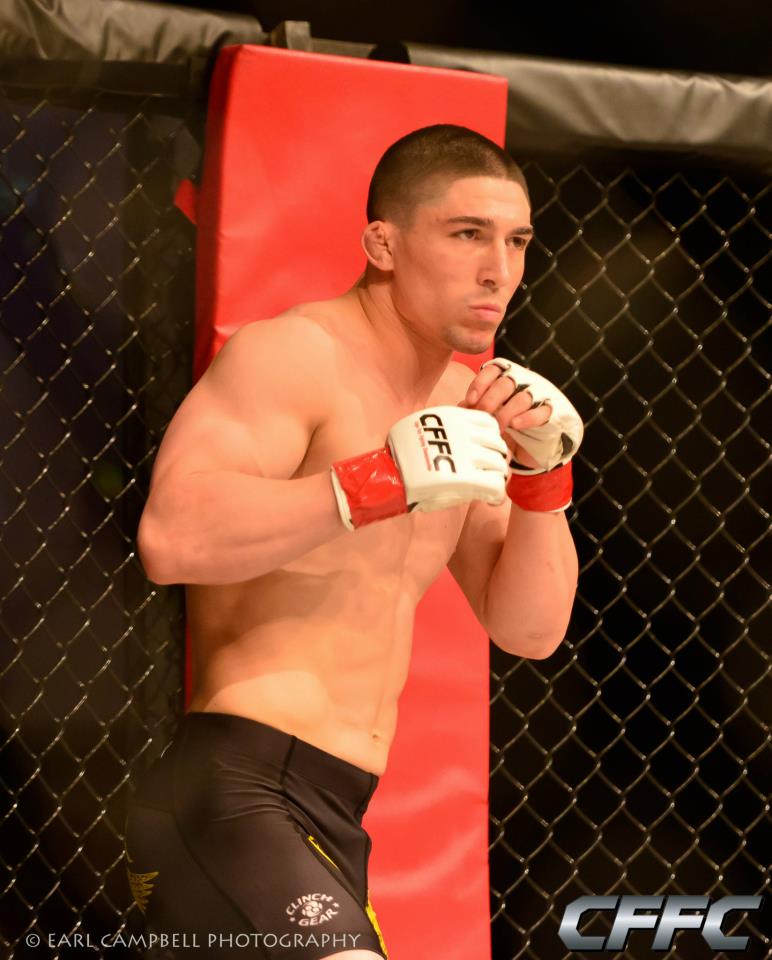 My Atlantic City adventure started with Corey Bleaken taking the cage against tough as nails Paul Felder. The fight was high on drama from the start, with Corey getting clipped with a hard cross and waking up to find himself in a fully sunk rear naked choke. In this instance quitting was the most readily available option, but even half unconscious and unable to breath Corey escaped, seemingly by the force of pure will. He not only survived, but was able to get on top and mount some offense, shattering Felder’s nose in the process. Down one round Corey fought with a heightened sense of urgency and took round two on the strength of his top control.
My Atlantic City adventure started with Corey Bleaken taking the cage against tough as nails Paul Felder. The fight was high on drama from the start, with Corey getting clipped with a hard cross and waking up to find himself in a fully sunk rear naked choke. In this instance quitting was the most readily available option, but even half unconscious and unable to breath Corey escaped, seemingly by the force of pure will. He not only survived, but was able to get on top and mount some offense, shattering Felder’s nose in the process. Down one round Corey fought with a heightened sense of urgency and took round two on the strength of his top control.
When the bell sounded for the start of round 3 the crowd was on its feet. Both fighters clearly exhausted, bloody and determined put on an incredible display of heart and courage. Corey found himself on the bottom, but flawlessly executed multiple Heisaman escapes (click here to learn) to reverse and get back to his feet. Ultimately the pressure from Felder was too much and he took home the victory. Classy in victory, Felder was very respectful towards everyone at AMA Fight Club and reminded the crowd of how tough Bleaken was for the entire 15 minutes.
On the one hand the loss is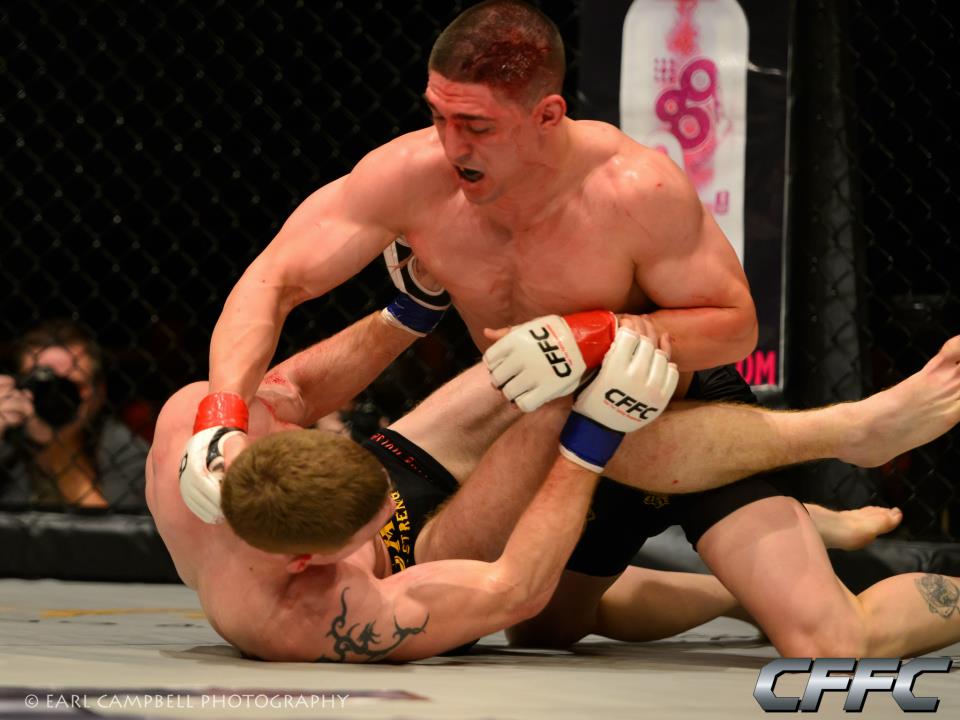 a set back – an unwanted bump in the road. However, for each young fighter coming up the ranks there are certain unanswered questions. Will he fold under pressure? Can he overcome adversity? Will his cardio hold up for 15 minutes? Can he recover from being dropped? Will he look for a way out when defeat is near? Corey has faced these crucibles and shown he possesses an iron will and indomitable fighting spirit. Progress is not always measured by tallies of wins and losses. Through the blood and sweat of this fight Corey may not have found victory, but in some ways he discovered something far more valuable. May God help the next poor soul who shares the cage with Mr. Bleaken.
a set back – an unwanted bump in the road. However, for each young fighter coming up the ranks there are certain unanswered questions. Will he fold under pressure? Can he overcome adversity? Will his cardio hold up for 15 minutes? Can he recover from being dropped? Will he look for a way out when defeat is near? Corey has faced these crucibles and shown he possesses an iron will and indomitable fighting spirit. Progress is not always measured by tallies of wins and losses. Through the blood and sweat of this fight Corey may not have found victory, but in some ways he discovered something far more valuable. May God help the next poor soul who shares the cage with Mr. Bleaken.
Following Corey’s battle all eyes were on Sean Santella. “Shorty” was looking to extend his win streak to five straight. As fight time approaches Shorty slowly goes through a transformation. He begins as an affable teammate and slowly transcends into a laser focused assassin. Once he completes his warmup and reviews his game plan his smile is replaced with a scowl. “It’s MY TIME!” he repeats louder each time as the fight approaches. Positive affirmations mixed with relentless intensity foreshadow the night’s performance.
Mike Constantino turns to me and predicts a Shorty victory via rear naked choke. I shake my head and tell him “Triangle…round 1”. Mike likes my premonition.
The fight starts with a long feeling out process, Shorty in the unique position of being the taller man. As expected Morgan shoots in and Shorty immediately begins his submission assault. A failed guillotine attempt brings the fight to full guard. Shorty traps the arm and slaps on his patented “Giant Cirlce” triangle. Morgan fights valiantly and attempts to slam his way out (unless you’re Quinton Jackson you should always posture out of a triangle rather than slamming imo), but ultimately passes out after refusing to submit.
The only thing more impressive than Shorty’s Jiu-jitsu transitions was his post fight break dancing routine. For his efforts Shorty earned a nice “Submission of the Night Bonus” (Corey 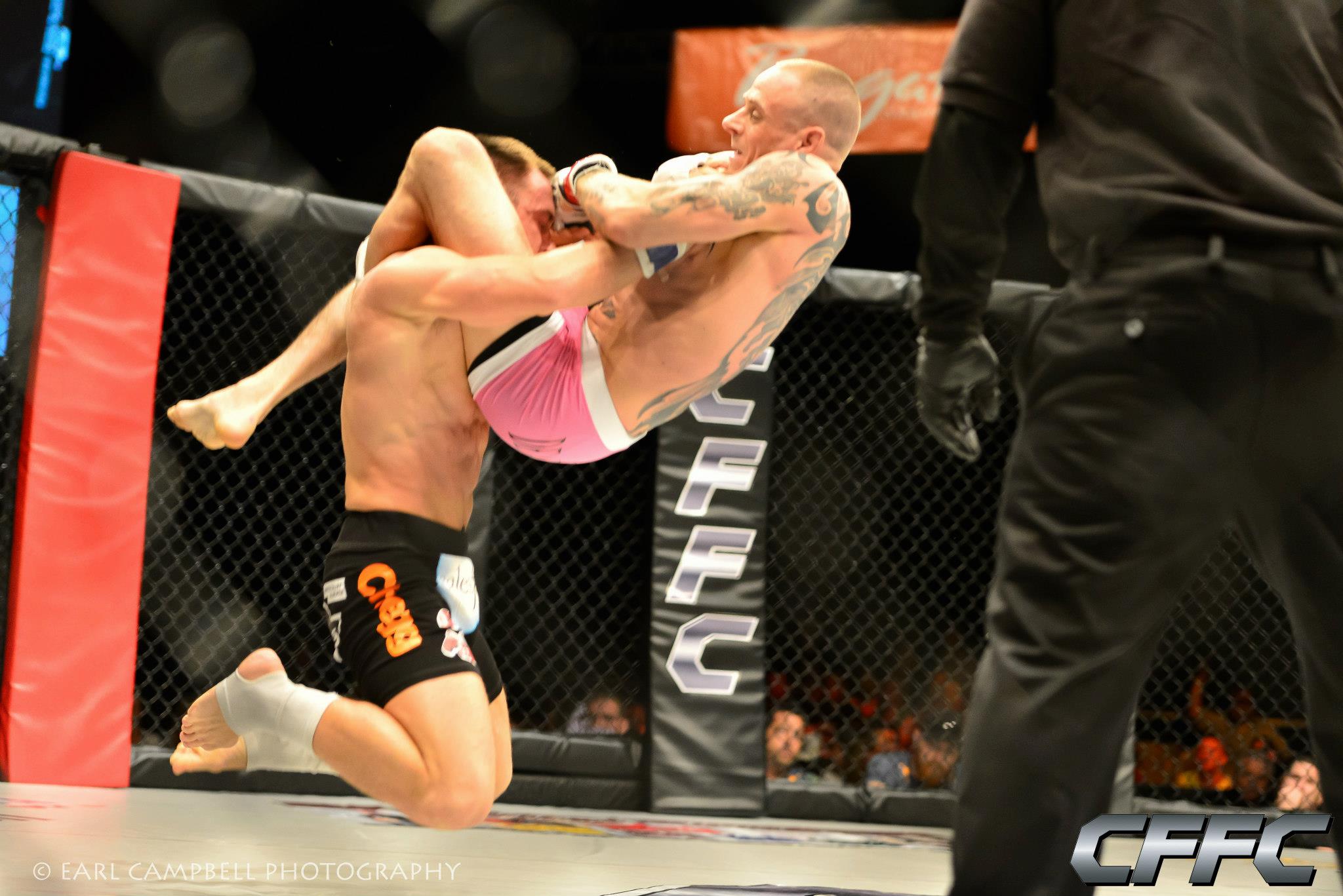 was awarded Fight of the Night). This was without question the best fight camp and performance of Shorty’s MMA career. Winning 9 out of his last 10 fights, Shorty has proven he is ready to step up to the big leagues. With victories over past and current Strikeforce and UFC veterans Shorty isn’t simply ready to compete in the best organization, he could challenge for the title.
was awarded Fight of the Night). This was without question the best fight camp and performance of Shorty’s MMA career. Winning 9 out of his last 10 fights, Shorty has proven he is ready to step up to the big leagues. With victories over past and current Strikeforce and UFC veterans Shorty isn’t simply ready to compete in the best organization, he could challenge for the title.
The other star performance came from my training partner and friend Joe Pinto. Joe showed age is just a number as he went out and dominated his 20 year old adversary en route to a TKO victory. Joe used some patented AMA ground and pound tricks to eventually progress to back mount, flatten his opponent out and rain down blows until his hand was raised. I watched this fight from the stands and apologize for the hearing loss I inflicted on those around me.
Live in Poughkeepsie and want to be the next MMA Champion?
Check out Precision MMA in LaGrange, NY the Hudson Valley’s top Poughkeepsie MMA gym call 845-392-8495 or visit http://www.poughkeepsiemixedmartialarts.com
Kaensak Seminar – Poughkeepsie Muay Thai
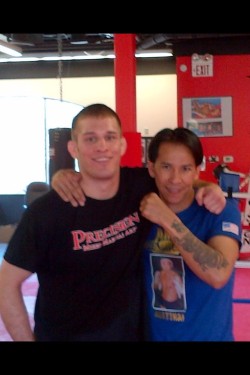 This was a busy weekend for me. I had my muay thai coach Kaensak come to my school for a muay thai seminar. Kaensak is a muay thai legend – over 300 fights, multiple time Thailand “Fighter of The Year” and a Lumpinee Stadium Champion. It’s almost unreal that I’m able to have someone of his stature teach me muay thai in my small section of Poughkeepsie. I started working with Kaensak about 2 years ago. I had heard a lot of hype about him, but I was very skeptical. I knew he was a great fighter, but I’ve seen plenty of champions who couldn’t teach whatsoever. My skepticism was completely unfounded though. Kaensak completely blew my mind. He opened up a whole new world of muay thai to me. His style is flashing but deceptively simple. Use a handful of effective techniques, but always feint, disguise and keep your opponent guessing. The amazing thing is that I’ve never scene his techniques shown by anyone else. I feel like I stumbled across hidden treasure.
This was a busy weekend for me. I had my muay thai coach Kaensak come to my school for a muay thai seminar. Kaensak is a muay thai legend – over 300 fights, multiple time Thailand “Fighter of The Year” and a Lumpinee Stadium Champion. It’s almost unreal that I’m able to have someone of his stature teach me muay thai in my small section of Poughkeepsie. I started working with Kaensak about 2 years ago. I had heard a lot of hype about him, but I was very skeptical. I knew he was a great fighter, but I’ve seen plenty of champions who couldn’t teach whatsoever. My skepticism was completely unfounded though. Kaensak completely blew my mind. He opened up a whole new world of muay thai to me. His style is flashing but deceptively simple. Use a handful of effective techniques, but always feint, disguise and keep your opponent guessing. The amazing thing is that I’ve never scene his techniques shown by anyone else. I feel like I stumbled across hidden treasure.
Being the nice guy that I am I wanted to share the wealth with my muay thai students over in Poughkeepsie, NY at Precision MMA. Kaensak showed us all muay thai we could handle for two hours. He started with fundamental defense, then built to counter striking off catching your opponent’s kicks and finished with some very sneaky clinch techniques. There was a mixed bag of basics and flash.
If you live in the Poughkeepsie area and love striking check out my Poughkeepsie Muay Thai classes at Precision MMA call 845-392-8495 or visit http://www.poughkeepsiemuaythai.com

